This post is the first of a series of that I will attempt to write once a month as a form of newsletter dedicated to some of the more interesting ideas and activities that surface on social media and from various other sources. I find it exciting and heartening to read about various innovative global VS activities, often taking place under difficult conditions, as well as the many new ideas and developments that surface from time to time. I have always said that if vetiver will grow at a location, then there is no end to what the user can do with it – it’s all about need, design, architecture, innovation, and motivation
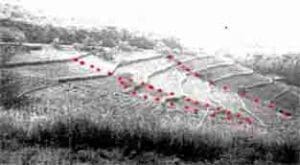
To start this monthly news update I thought I would share with you a note I received from Vonnie Roudette who leads various vetiver initiatives in St Vincent and the Grenadines (Caribbean). You will remember that she developed a wonderful vetiver handicraft program (see video The Grass Men) involving those serving time in prison. A new project (Vetiver Systems Technology Applications for Farmland Restoration, Land Conservation and Sustainable Livelihoods for farmers in St Vincent’s North Leeward Orange Zone) that she is leading includes the rehabilitation of old vetiver plantings that were planted more than 80 years ago prior to WWII (in those days it is said that Imperial Airways diverted the flight path to show the passengers these “wonderous” soil conservation works. In her words “We have identified 8 old planting sites in the area of North Leeward – I am finding it really exciting as we discover more through drone footage. It seems that just a fraction of the original plantings remain, but it is still significant, and we are restoring one site with the involvement of farmers who work the land in the area. I was overjoyed to hike through the old hedgerows – some of the deepest terraces are 8-12 ft high! The effect of last year’s volcanic eruption remains and we have been working in inches of ash which has also served to dry out the earth considerably. The community involvement is 100% and they are so excited to learn more about the vetiver that they have grown up with, but not fully understood its purpose and history. We are sourcing vetiver from other areas for the replanting as I don’t want to disturb any of the original plantings.” Vonnie promises to send more as the project progresses.
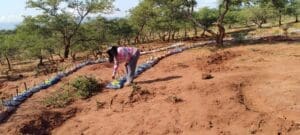
Jane Wegesa, Vetiver Network coordinator for Kenya, was a Founder of PLUS-Kenya, a group that promotes sustainable land management in Kenya, with VS as a key component. She has worked with VS for about 12 years and is very committed and active supporting communities and users of all types with VS applications. Over the years she and others have worked with the rehabilitation of highly eroded farmland, including the Kerio Valley – hot and dry. Her Facebook post shows some of the awful state of the land in West Pokot County — heavily eroded and gullied. The farmers there are facing the negative impact of climate change – drought and intermittent extreme rainfall events. The latter creates huge amounts of runoff (rainfall that needs to be kept on the land) and major sheet and gully erosion. It is difficult to establish vetiver under such conditions, since under the high velocity flooding created by the heavy rain it is difficult to establish vetiver. Jane and her farmers (a University of Nairobi project) are solving this problem by creating earth bag contour lines in which they plant vetiver. We know from applications in the Congo that this works for large scale gully reclamation and we can expect the same in Kenya. Vetiver will grow through the bags, the bags will degrade, and a vetiver hedge should then be in place and fully functionable. This should be another site on our watch list. Jane’s post solicited some interesting comments including from Dave Riley (Queensland) — “ In the Australian context of the relentless shift between drought and flooding, I think bagging is a game changer — especially when ‘leaky dams’ are part of the build. Or if designing a keyline landscape (Yeomans) — without requiring major earth moving effort and equipment. So the bags are really useful in reshaping water flow across the contour in a conscious pattern of re-working the water flow so that more of it is encouraged to enter the soil rather than wash away during a downpour. No need to fret over swale digging, either. Bagging is a soft intervention which can be adapted and improvised as the seasons pass over the land, and as conditions change.”

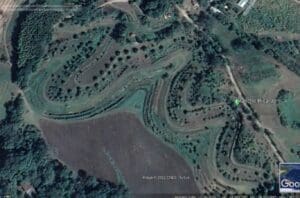
In response to Dave Riley, Antonio Carrillo Bolea who farms in Mexico posted – “We are moving towards the biggest Vetiver System with regenerative agriculture in Mexico. We have been working for four years in establishing the vetiver system on a Keyline hydrologic design to improve soil nutrition and avoid crop loss and damage after extreme precipitation events. We are in the Tuxtlas region, south of the Gulf coast, with more than 2000 mm annual rainfall. We are still working on the vetiver standards for propagation and management. Will share with you all when finished for your valuable feedback”….. No earth moving here, just an intelligent use of vetiver hedgerows and buffer strips. Vetiver hedgerows can be planted on a graded contour to enable lateral flow of water to collection ponds where necessary. But for rainfed farmers the best place for water is in the soil and in the supporting water tables where evapotranspiration losses are minimized.
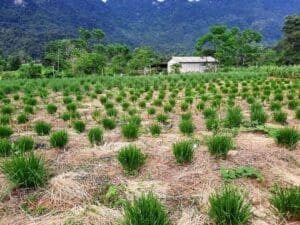
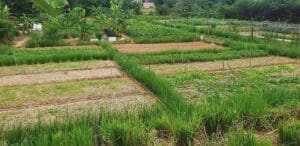
Ngo Duc Tho from Vietnam, leads the Vietnam Vetiver Farmers Group, and over the past few years he has been responsible for encouraging, with great success the embedment of vetiver into the farm system. This work often involves regenerative agricultural practices. Tho regularly posts feedback from Vietnam farmers who are experimenting with and developing techniques using vetiver as a tool to combat increasing drought, soil fertility problems, and for land reclamation. In his most recent post he describes a typical challenge: “Xi Man is located in Ha Giang province, Vietnam with an altitude of over 1,200m. The practice of farming without cover and the abuse of chemical fertilizers, causes the soil to become degraded, and the yield and quality of soybeans and maize will decrease. Farmers will clear the forest in search of more fertile land. We brought vetiver here, along with cover farming, symbiotic farming, groundwater recharge, and fodder, vetiver will change this land!”
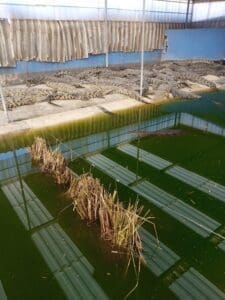

Vetiver and crocodiles. Yes, croc farming in Kwa Zulu-Natal, South Africa, where croc farmer, Darryl de Lange, was having problems with croc ponds heavy with blue green algae and other BODs. Darryl placed large clumps of vetiver within a circle of wire that was kept in place through vertical wires connected to an overhead horizontal wire (note there are no floating pontoons and Darryl system is something new – worth following). Within two weeks his croc pond water became clear enough to see left over bones from croc dinners. We don’t know how the crocs have taken to the vetiver or how they like the clean water! You can follow the discussion here
Coral reef protection – sediment and chemical contaminants inflows have to be reduced. Many years ago in Mauritius vetiver was grown as a hedge barrier to prevent creeping stoloniferous grasses from invading tea gardens. In more recent times it has been used for erosion control and landscaping on Mauritius golf courses. Now an environmental activist, Greet Meulepas, is taking small steps to expand the use of vetiver for protection of coral reefs …. “Hello everyone, I am new to this group and a complete vetiver-beginner. I am looking to promote the use of vetiver around the island of Mauritius mainly to purify water from herbicides and pesticides before it enters the ocean. I hope this will help the coral reefs surrounding Mauritius to recover. I am hoping to reach owners of hotels, golf courses and farms especially.

Of course the other benefits of planting vetiver (like acting against erosion) are a very welcome surplus …. Our first small step has been taken. The more I read about Vetiver the more I am astonished about its capacities. Our plan is to organise planting events and inform the people about the wonders that Vetiver can do. Our main goal: give the reefs surrounding Mauritius a fighting chance”. Greet is an example of how individual initiatives and actions on climate change, however small they may be at the start, will if they make sense, become bigger. There are examples of vetiver being used to reduce contaminants from reaching coastal waters. A nicely documented one by Don Miller (New Zealand) shows the successful application of VS in Vanuatu and the resulting decrease in coastal sedimentation.

Peter Pitcher, a regular contributor (see his vetiver photos) from the outback of Queensland shared the results of applying vetiver in the construction and stabilization of a causeway between two ponds on his property. Interestingly he planted vetiver on either side of the causeway to-be, and then year by year added soil fill between the hedges. As the hedges grew he added more fill and over a few years he ended up with a fully stable causeway approximately 1 meter high. See his 2018 post showing the early fill applications.
Another Queenslander who regularly contributes to our network is Dave Riley. Here is his useful “how-to”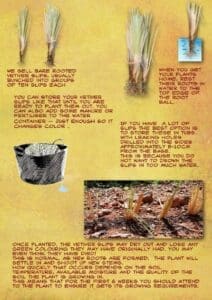 flier that he distributes in his community of gardening permaculturists when they buy his vetiver plants. Simple and clear messages like this one are very useful and helpful to those taking up vetiver for the first time.
flier that he distributes in his community of gardening permaculturists when they buy his vetiver plants. Simple and clear messages like this one are very useful and helpful to those taking up vetiver for the first time.
Well, I hope you may have found a few ideas in this newsletter, and please give me some feedback via a comment. Let me know what you are interested in especially, and I will try to dig some out from our extensive document center. Remember if you want to receive notifications of new posts and newsletters like this one you must register.